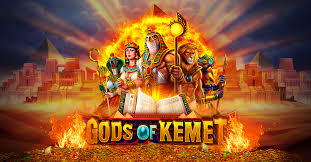
The civilization of Ancient Egypt, often referred to as Kemet, is a fascinating tapestry of mythology, culture, and monumental achievements. One can scarcely embark on a journey through this ancient world without encountering the rich pantheon of deities that shaped its people’s beliefs and daily lives. In the realm of modern entertainment, the allure of Ancient Egypt also finds expression in gaming, notably through titles like Gods of Kemet Slots—a game that intertwines the mythological significance and grandeur of this great civilization with the excitement of slots.
As we delve into the depths of Ancient Egypt, let us uncover its history, culture, religion, architecture, and the role of these elements in shaping the identity of one of humanity’s most influential civilizations.
The Historical Tapestry of Ancient Gods of Kemet Slots
The history of Ancient Egypt is a chronicle of incredible resilience, innovation, and transformation. This vast timeline spans thousands of years, marked by distinct eras characterized by both continuity and change https://u888.prof/.
Pharaonic Dynasties: The Rise and Fall
The pharaohs of Egypt were not just rulers; they were considered divine entities who bridged the human and celestial worlds. Their reigns are categorized into several dynastic periods, each reflecting varying degrees of achievement and turmoil.
From the Old Kingdom, known for the construction of the iconic pyramids, to the New Kingdom, which heralded a time of wealth and military power, the dynamics of leadership shifted dramatically over centuries.
The transition from one dynasty to another often involved strife, intrigue, and sometimes even warfare, but it also led to significant advancements in art, writing, and governance.
Important Pharaohs and Their Legacies
During the Old Kingdom, Pharaohs such as Khufu and Sneferu left an indelible mark on architectural practices with their ambitious pyramid-building projects.
Khufu’s Great Pyramid at Giza remains one of the Seven Wonders of the Ancient World, showcasing the Egyptians’ sophisticated understanding of mathematics and engineering.
In contrast, the New Kingdom produced some of the most renowned rulers like Ramses II and Hatshepsut, whose reigns were notable for cultural flourishing and extensive building projects, including many temples dedicated to the gods.
The divine aspect of pharaohs often made them central figures in religious practices, reinforcing the connection between governance and spirituality.
Cultural Shifts and Influences
As Egypt interacted with neighboring cultures, especially during the periods of foreign rule, shifts in traditions became apparent.
The influence of the Hellenistic world post-Alexander the Great introduced new ideas in philosophy, science, and art, which began to merge with traditional Egyptian customs.
This dynamic interplay illustrates how Ancient Egypt was an evolving civilization, adapting to external influences while still preserving its core identity.
Religion: The Heart of Kemet
Religion permeated every facet of life in Ancient Egypt. The Egyptians held a complex belief system characterized by a plethora of gods and goddesses who governed various aspects of the natural and supernatural worlds.
The Pantheon of Deities
The gods of Kemet were far more than mere symbols; they embodied concepts crucial to Egyptian life. For example, Osiris represented resurrection and the afterlife, while Isis personified motherhood and magic.
The duality of life and death played a pivotal role in their worship. Temples, rituals, and festivals revolved around the cycles of nature and agriculture, reflecting the Egyptians’ profound respect for their environment.
Deities were often depicted in human form, adorned with symbolic imagery that conveyed their powers and domains.
Worship Practices and Temples
Temples served as the earthly abodes of the gods and were central to public worship. These grand structures housed statues of the deities and were sites of elaborate rituals performed by priests.
Festivals such as Opet celebrated the god Amun and his union with the queen, serving to reinforce the divine right of pharaohs.
Personal piety also played a role, with individuals partaking in domestic worship and offering prayers or sacrifices to seek favor from the gods.
The Afterlife Beliefs
Belief in an afterlife significantly influenced burial practices. The pursuit of immortality led to the development of mummification, which preserved the body for the journey into the next world.
The Book of the Dead, a collection of spells and guidelines, illustrated the expectations of the afterlife and served as a guide for souls navigating the trials they faced.
Such cultural priorities underscore the deep-seated beliefs about existence and the continuum of life beyond death in Ancient Egyptian society Gods of Kemet Slots.


